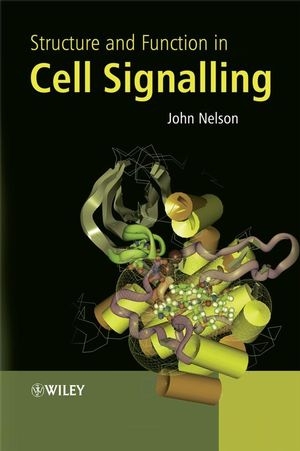
Structure and Function in Cell Signalling
Wiley-Blackwell (Verlag)
978-0-470-02551-2 (ISBN)
- Titel ist leider vergriffen;
keine Neuauflage - Artikel merken
"This book contains extremely detailed and informative content on structure and function of ligands, receptors, and signalling intermediates plus interactions ...the extent of detail and appropriate referencing is impressive." -Microbiology Today, July 2009 "A very well-written book suitable for use as a reference or textbook for an undergraduate subject in cell signalling. For researchers interested in the molecular basis of cell signalling and how aberrant regulation of cell signalling proteins causes diseases, this is an excellent resource of biochemical and structural information." -Australian Biochemist, August 2009 "From basics to details, this is an elegantly written and carefully edited book. The chapters on cell cycle control and oncogenesis are particularly fascinating and valuable to biomedical research. This is the book to have if you are interested in molecular mechanisms of signal transduction. It is a great introduction to the literature that will be welcomed by students and experts alike." -Doody's, January 2009 This text is a concise and accessible introduction to the dynamic but complex field of signal transduction.
Rather than simply cataloguing all signalling molecules and delineating every known pathway, this book aims to break signalling down into common elements and activities - the 'nuts and bolts' of cellular information exchange. With an emphasis on clarity of presentation throughout, the book teaches the basic principles focusing on a mature core of knowledge, providing students with a foundation of learning in this complex and potentially confusing subject. It also addresses the issue of variation in the numbering of key amino acids as well as featuring interaction with RasMol software, and exercises to aid understanding.* An accessible introduction to the complex field of cell signalling* Interacts with RasMol software - freely downloadable for viewing structures in 3D* Includes exercises and clear instructions in the use of RasMol* Well illustrated in full colour throughout Structure and Function in Cell Signalling is an invaluable resource to students across a range of life science degree programmes including biochemistry, cell and molecular biology, physiology, biomedicine and oncology. This book provides a clear, accessible introduction to this rapidly expanding field.
John Nelson, Queen's University, Belfast, UK.
Acknowledgments. Preface. 1 The components and foundations of signalling. 1.1 Definition of terms used. 1.2 Historical foundations. 1.3 Early milestones in signal transduction research. 1.4 The discovery of receptors and G proteins. 1.5 cAMP pathways. 1.6 cAMP: ancient hunger signal - primitive signalling in amoebazoans and prokaryotes. References. 2 Enzymes and receptors - quantitative aspects. 2.1 Enzyme steady state assays - Michaelian enzymes. 2.2 Receptor equilibrium binding assays. 2.3 The receptor's environment. 2.4 Guanine nucleotides and the agonist 'affinity-shift' of 7-pass receptors. References. 3 Modules and motifs in transduction. 3.1 Src homology domains. 3.2 PH superfold modules: PH-, PTB- and PDZ-domains. 3.3 Bcr-homology (BcrH) domains. 3.4 Dbl homology (DH) domains - partners of PH domains. 3.5 Bcl-2 homology (BH) domains. 3.6 Ras binding domains. 3.7 Phosphoserine/phosphothreonine-binding domains. 3.8 EF-hands - calcium-sensing modules. 3.9 C1 and C2 domains - a Ca2p-activated, lipid-binding, module. References. 4 Protein kinase enzymes - activation and auto-inhibition. 4.1 The protein kinase fold. 4.2 Protein kinases activated by A-loop phosphorylation. 4.3 The insulin receptor kinase (IRK) - a 'gated' kinase. 4.4 Cyclin dependent kinases. 4.5 Secondary inhibition mechanisms - PKA. References. 5 7-pass receptors and the catabolic response. 5.1 7-pass receptor phylogeny. 5.2 Functional mechanisms of 7-pass receptors. 5.3 Amplification. 5.4 Adenylyl cyclase - signal limitation. 5.5 Adenylyl cyclase isoforms. 5.6 G proteins and the adenylyl cyclase effector isoforms. 5.7 Regulatory subunits of PKA and A-Kinase Anchoring Proteins. 5.8 Phosphorylase kinase. 5.9 Glycogen phosphorylase. 5.10 Glycogen synthase. 5.11 Remaining questions - scaffolds and alternate second messenger 'receptors'. 5.12 G protein coupled receptor kinases - downregulators, signal integrators. References. 6 Single pass growth factor receptors. 6.1 Receptor tyrosine kinases - ligands and signal transduction. 6.2 The PDGFR family - signal transduction. 6.3 PDGFR family autoinhibition: juxtamembrane and A-loop tyrosines. 6.4 Crystal structure of kinase domain of PDGFR family-A member: Flt-3. 6.5 The ErbB family. 6.6 ErbB-type receptor signal transduction particles. 6.7 Autoinhibition of EGFR and activation. References. 7 G proteins (I) - monomeric G proteins. 7.1 Classification. 7.2 ON and OFF states of Ras-like proteins. 7.3 Raf - a multi-domain serine/threonine kinase family of Ras effectors. 7.4 Ras protein structure and function. 7.5 The switch mechanism: hydrolysis-driven conformational change in Ras. 7.6 GTP hydrolysis. References. 8 G proteins (II) - heterotrimeric G proteins. 8.1 Classification and structural relationship with Ras. 8.2 Ga-subunits: the Ras-like core, G-boxes and switch regions. 8.3 GTP exchange, hydrolysis and switch movements. 8.4 b/g- and receptor-binding surfaces of a-subunits. 8.5 Modulators of G protein activity - the 'RGS' protein family. 8.6 Signal transduction by b/c subunits. References. 9 The insulin receptor and the anabolic response. 9.1 The insulin receptor - a pre-dimerised RTK with a unique substrate. 9.2 InsR and IGF-IR: differentiation leads differential tissue effects. 9.3 Features of metabolic control in key tissues. 9.4 InsR downstream signalling pathways. 9.5 The insulin receptor substrate - a surrogate signal transduction particle. 9.6 IRS-1/2 phosphorylation and PI-3-kinase activation. 9.7 Protein phosphatase-1 (PP-1). 9.8 Insulin reverses effects of adrenaline and/or glucagon. 9.9 PIP3 downstream effects - glycogen synthesis. 9.10 Many questions remain. References. 10 Mitogens and cell cycle progression. 10.1 The mitogenic response and the cell division cycle. 10.2 G0, competency, and the point of no return in G1 - the 'R-point'. 10.3 Oncogene products derived from growth factor pathway components. 10.4 Transcription and cyclins. 10.5 Cyclin dependent kinases. 10.6 Deactivation by cyclin destruction. 10.7 Cyclin dependent kinases - activation through cyclin synthesis. 10.8 Mitogenic pathway downstream of single pass tyrosine kinase receptors. 10.9 CyclinD/Cdk-4/6 - only important substrate is RB. 10.10 Retinoblastoma-related 'pocket proteins' - negative modulators of E2F. 10.11 De-repression of the cyclin E gene by cyclin D/Cdk-4/6. 10.12 Cyclin A/Cdk-2 - S-phase progression and termination. 10.13 The controlled process of mammalian DNA replication. 10.14 Cyclin B translocations and M-phase. 10.15 Cdk inhibitors. 10.16 p53 cell cycle arrest and apoptosis. 10.17 7-pass receptors and mitosis. 10.18 Concluding remarks and caveats. References. Appendix 1: Worked examples. A.1 Enzyme and receptor assays worked out from raw data examples. A.1.1 An alkaline phosphatase assay. Appendix 2: RasMol: installation and use. Index.
| Erscheint lt. Verlag | 1.8.2008 |
|---|---|
| Verlagsort | Hoboken |
| Sprache | englisch |
| Maße | 171 x 247 mm |
| Gewicht | 884 g |
| Themenwelt | Naturwissenschaften ► Biologie ► Mikrobiologie / Immunologie |
| Naturwissenschaften ► Biologie ► Zellbiologie | |
| ISBN-10 | 0-470-02551-4 / 0470025514 |
| ISBN-13 | 978-0-470-02551-2 / 9780470025512 |
| Zustand | Neuware |
| Haben Sie eine Frage zum Produkt? |
aus dem Bereich


